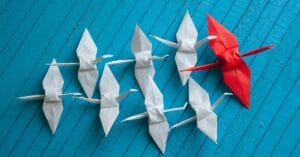Psychologist researcher Bruce Tuckman formed Tuckman’s Model as part of his 1965 paper Developmental Sequence in Small Groups.
The US Navy tasked him, along with a group of other social psychologists, with analysing the dynamics of forming a team, and how the leadership style changes as the group develops.
⏰Key Points:
- Tuckman and his colleagues found there were four stages of team development: orientation, conflict, cohesion and functional-role relatedness.
- Tuckman reworked them into four simple – and more memorable – stages: forming, storming, norming and performing.
- Tuckman’s Model is fairly simple to understand and it’s easy to remember, which means your staff should be able to learn and implement it quickly.
Forming
This is the bringing together of strangers in the hopes they’ll eventually be able to work as a highly functioning team.
As you’ve likely experienced yourself, when you join a new team, you want to get stuck in right away but you might not have a clear idea of what you’re supposed to be doing. And nor does anyone else. You don’t really know these people, so the atmosphere is reserved yet positive.
Employees may feel nervous, excited or curious at the forming stage – it’s all new and there’s a lot happening. As a leader, you’ll need to be aware of how each team member feels and set the direction, so the team can get on with the task at hand. Expect plenty of questions as your team finds their feet.
This stage doesn’t focus so much on proper processes, or even having clearly defined roles.
How can leaders help their employees at this stage?
- Create a team roadmap (its purpose, how it’ll work, and the expected outcomes)
- Have team members set personal goals
- Schedule informal chats so your team can get to know each other faster
Storming
While settling into the new team and starting the task that has been set by the leader, the team will become more familiar.
You’ll get to know your team members’ personalities and attitudes to working. There might be clashes, and some will start to question the leadership and challenge decisions because they believe there’s a better way. Understandably, this can lead to a stormier atmosphere.
As the leader, you’ll need to manage that social interaction and focus the team back on their goals. It’s important to make sure each team member has an equal voice.
The storming stage is necessary to iron out problems and for group members to work out where they fit in to the wider team dynamic.
How can leaders help their employees at this stage?
- Set up processes to track progress and success of tasks
- Ask your team to help you to build trust
- Don’t let disagreements linger and remember that opposing views find different faults and solutions
- Make sure quieter team members get a chance to voice their opinion
Norming
Now you’ve made it to the norming stage.
Tuckman said this is where the team members have their role, understand the work and know their fellow employees. Your group might be more interested in collaborative activities and start interacting socially outside of work.
This is where you can work together to develop team processes. Leadership responsibilities can be shared as you facilitate and enable your team.
By establishing a routine during the storming stage, you’ve laid down the norms of behaviour that are accepted and understood by the team. You’ve found your rhythm, now you’ve just got to perform it.
How can leaders help their employees at this stage?
- Team building – you know your team by now, so make sure this is something they’ll actually enjoy. It doesn’t have to always be work-related
- Use 1-2-1 sessions to get your employees to look at their progress and take responsibility for their goals
Performing
Everyone has a clear shared vision of their roles and processes, and they’re focused on meeting the team’s goals.
As a leader, you’ll still need to delegate and manage the group, but generally they should trust their fellow team members and be mostly independent with their work so you shouldn’t need to interfere.
Disagreements are usually resolved happily, and any changes are decided collectively. The team will look out for each other and have an awareness of the wider company strategy.
You might find you’re not asked for instructions or assistance as often. Instead, your team might ask for help with personal development to help them perform better.
How can leaders help their employees at this stage?
- Continue building your team’s relationships with group activities, informal meetings, collaborative work and by delegating tasks
- You’ll likely have more free time, so you can focus on other goals and new ways your team can help the business
- Check in on the team’s personal development and discuss what options are available to them
Adjourning – the fifth stage
In 1975, Tuckman outlined a fifth phase. Adjourning is where the team’s goals have been achieved, so the members go their separate ways to work on other teams or leave the business altogether.
Not all organisations will find this step relevant, as it’s not always the case that teams are broken up once their objectives have been met.
How can leaders help their employees at this stage?
- Celebrate achievements – you worked hard, and shared experiences will make it easier if you’re teamed up with the same people again
- Boost team members’ confidence by giving them feedback and deserved praise at company meetings. Offer to write references for them if they’re moving elsewhere
What effects can understanding Tuckman’s Model have on staff?
Advantages
Tuckman’s Model is fairly simple to understand and it’s easy to remember, which means your staff should be able to learn and implement it quickly.
It also gives managers and team leaders an idea of what to expect when bringing their team together.
Disadvantages
But the major downside of this model is it assumes that the team will evolve from one step to the next, with distinct changes in dynamics.
Instead, you might find that your staff progress at different rates. The whole team could also move backwards – from performing back to storming – or skip a stage altogether, particularly if there’s pressure from the business to succeed.
Conclusion
While Tuckman’s Model can provide some guidance towards making a successful team, it’s also important to observe individual members to find out what they need to help them thrive as individuals.







